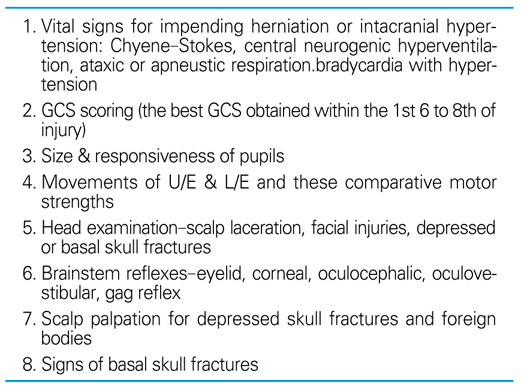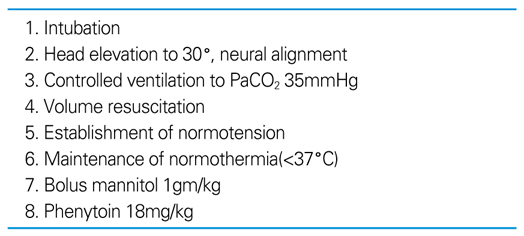 |
 |
- Search
| J Korean Med Assoc > Volume 50(8); 2007 > Article |
Abstract
Despite aggressive management, severe emotional and physical disability or death occurs in the majority of patients with severe head injury. Significant recovery of function of impaired neuronal cells is possible if patients are rapidly and effectively resuscitated after focal or diffuse brain insults. However, if secondary insults such as hypotension, hypoxia, or intracranial hypertension occur, many vulnerable cells may be irreversibly damaged by a cerebral ischemia. The most important points in the management of traumatic brain insults are the maintenance of an adequate cerebral perfusion pressure rather than the control of intracranial hypertension as a means of averting cerebral ischemia, and recognition that aggressive hyperventilation to control increased cerebral pressure may aggravate cerebral ischemia. So it is recommended that cerebral perfusion pressure be maintained at or above 70mmHg and that use of prophylactic hyperventilation (PaCO2 < 35mmHg) should be avoided within the 1st 24 hours after brain injury.
References
1. Chesnut RM, Marshall LF, Marshall SB. In: Cooper PR, editor. Medical management of intracranial pressure. Head injury 1993;3rd ed. Baltimore: Williams & Wilkins. 225-246.
2. Hovda DA, Becker DP, Katayama Y. Secondary injury and acidosis. J Neurotrauma 1990;9:S47-S60.
3. Graham DI, Adams JH, Doyle D. Ischemic brain damage in fatal non-missile head injuries. J Neurol Sci 1978;39:213-234.
4. Jennett B, Carlin J. Preventable mortality and morbidity after head injury. Injury 1978;10:31-39.
5. Bouma GJ, Muizelaar JP, Bandoh K, Marmarou A. Blood pressure and intracranial pressure-volume dynamics in severe head injury relationship with cerebral blood flow. J Neurosurg 1992;77:15-19.
6. Muizelaar JP, Ward JD, Marmarou A, Newlon PG, Wachi A. Cerebral blood flow and metabolism in severely head-injured children. Part 2: Autoregulation. J Neurosurg 1989;71:72-76.
7. Gray WJ, Rosner MJ. Pressure-volume index as a function of cerebral perfusion pressure. Part 2: The effects of low cerebral perfusion pressure and autoregulation. J Neurosurg 1987;67:377-380.
8. Marion DW, Obrist WD, Penrod LE, Darby JM. Treatment of cerebral ischemia improves outcome following severe traumatic brain injury. Abstract 1993;The 61th Annual Meeting of the American Association of Neurosurgical Surgeons. Boston, MS.
9. Rosner MJ, Rosner SD. CPP management: II. Optimization of CPP or vasoparalysis does not exist in the living brain 1994;Presented at Ninth Internatinal Symposium on Intracranial Pressure. Nagoya, Japan.
10. Young JS, Blow O, Turrentine F, Claridge JA, Schulman A. Is there an upper limit of intracranial pressure in patients with severe head injury if cerebral perfusion pressure is maintained? Neurosurg Focus 2003;15:E2.
11. Bouma GJ, Muizelaar JP. Relationship between cardiac output and cerebral blood flow in patients with intact and with impaired autoregulation. J Neurosurg 1990;73:368-374.
12. Kelly DF, Dordestani RK, Shalmon E. Hyperemia-associated intracranial hypertension following human traumatic brain is uncommon 1995;To be presented at: Third International Neurotrauma Symposium. Toronto, Canada.
13. Kelly DF, Doberstein C, Becker DP. In: Narayan RK, Wilberger JE, Povlishock JT, editor. General principles of head injury management. Neurotrauma 1996;1st ed. New York: McGraw Hill. 71-101.
14. Rosner MJ, Daughton S. Cerebral perfusion pressure management in head injury. J Trauma 1990;30:933-941.
15. Balestreri M, Czosnyka M, Hutchinson P, Steiner LA, Hiler M, Smielewski P, Pickard JD. Impact of intracranial pressure and cerebral perfusion pressure on severe disability and mortality after head injury. Neurocrit Care 2006;4:8-13.
16. Huang SJ, Hong WC, Han YY, Chen YS, Wen CS, Tsan YS, Tu YK. Clinical outcome of severe head injury in different protocol-driven therapies. J Clin Neurosci 2007;14:449-454.
17. Rosner , Rosner SD. CPP management. Results 1994;Presented at Ninth International Symposium on Intracranial Pressure. Nagoya, Japan.
18. Miller JD. Evaluation and treatment of head injury in adults. Neurosurg Q 1992;2:28-43.
19. Chi JH, Knudson MM, Vassar MJ, McCarthy MC, Shapiro MB, Mallei S, Holcroft JJ, Moncrief H, Noble J, Wisner D, Kaups KL, Bennick LD, Manley GT. Prehospital hypoxia affects outcome in patients with traumatic brain injury: A prospective multicenter study. J Trauma 2006;61:1134-1141.
20. Ommaya AK, Gennarelli TA. In: Vinken PJ, Bruyn GW, editor. Experimental head injury. Handbook of clinical neurology, vol 23 1975;Amsterdam: Elsevier-North Holland. 67-90.
21. Talucci RC, Shaikh KA, Shaikh CW. Rapid sequence induction with oral endotracheal intubation in the multiply injured patient. Am Surg 1988;54:185-187.
22. Hsiang JK, Chesnut RM, Crisp CB, Klauber MR, Blunt BA, Marshall LF. Early routine paralysis for intracranial pressure control in severe head injury is it necessary? Crit Care Med 1994;22:1471-1476.
23. Manley G, Knudson MM, Morabito D, Damron S, Erickson V, Pitts L. Hypotension, hypoxia, and head injury frequency, duration and consequences. Arch Surg 2001;36:1118-1123.
24. Wilberger JE. In: Cooper PR, editor. Emergency care and initial evaluation. Head Injury 1993;3rd ed. Baltimore: Williams & Wilkins. 27-41.
25. Scalea T, Martz S, Duncan A. Fluid resuscitation in head injury. American Association for the Surgery of Trauma Abstract Book 1989;09. New York: American Association for the Surgery of Trauma.
26. Kaieda R, Todd MM, Cook LN, Warner DS. Acute effects of changing plasma osmolarity and colloid pressure on the formation of brain edema after cryogenic injury. Neurosurgery 1989;24:671-678.
27. Sutin KM, Ruskin KJ, Kaufman BS. Intravenous fluid therapy in neurologic injury. Crit Care Clin 1992;8:367-408.
28. Velanovich V. Crystalloid versus colloid fluid resuscitation. A meta-analysis of mortality. Surgery 1989;105:65-71.
29. Enevoldsen EM, Jensen JT. Autoregulation and CO2 responses of cerebral blood flow in patients with severe head injury. J Neurosurg 1978;48:689-703.
30. Rosner M. In: Wood JH, editor. Cerebral perfusion pressure. Link between intracranial pressure and systemic circulation. Cerebral Blood Flow 1987;New York: Mcgraw Hill. 425-448.
31. Changaris DG, McGraw CP, Richardson JD, Garretson HD, Arpin EJ, Shields CB. Correlation of cerebral perfusion pressure and Glasgow Coma Scale to outcome. J Trauma 1987;27:1007-1013.
32. Robertson CS, Clifton GL, Taylor AA, Grossman RG. Treatment of hypertension associated with head injury. J Neurosurg 1983;59:445-460.
33. Servadei F, Teasdale G, Merry G. Neurotraumatology Committee of the World Federation of Neurosurgical Societies. Defining acute mild head injury in adults. A proposal based on prognostic factors, diagnosis, and management. J Neurotrauma 2001;18:657-664.
34. Stein SC, Ross SE. Moderate head injury: A guide to initial management. J Neurosurg 1992;77:562-564.
35. Rosner MJ. In: Andrew BT, editor. Pathophysiology of management of increased intracranial pressure. Neurosurgical Intensive Care 1993;New York: McGraw Hill. 57-112.
36. Jones PA, Piper JR, Corrie J. Microcomputer based detection of secondary insults and 12 month outcome after head injury. Abstract 1993;International Neurotrauma Symposium. Glasgow, Scotland.
37. Gopinath SP, Robertson CS, Contant CF, Hayes C, Feldman Z, Narayan RK, Grossman RG. Jugular venous saturation and outcome after head injury. J Psychiatry Neurosci 1994;57:717-723.
38. Muizelaar JP, Marmarou A, Ward JD, Kontos HA, Choi SC, Becker DP, Gruemer H, Young HF. Adverse effects of prolonged hyperventilation in patients with severe head injury: A randomized clinical trial. J Neurosurg 1991;75:731-739.
39. Vollmer DG, Torner JC, Jane JA. Age and outcome following traumatic coma: why do older patients fare worse. J Neurosurg 1991;75:S37-S49.
40. Gennarelli TA, Champion HR, Sacco WJ, Copes WS, Alves WM. Mortality of patients with head injury and extracranial injury treated in trauma centers. J Trauma 1989;29:1193-1202.
41. McBride DQ, Patel AB, Caron M. Early repeat CT scan: Importance in detecting surgical lesions after closed head injury. (Abstract) 1993;6:2nd International Neurotrauma Symposium. Glasgow.
42. Stein SC, Spetell C, Young G. Delayed and progressive brain injury in closed-head trauma: radiological demonstration. Neurosurgery 1993;32:25-31.
- TOOLS
-
METRICS

-
- 0 Crossref
- Scopus
- 1,092 View
- 6 Download
-
Related articles in
J Korean Med Assoc -
Management of Brain Death and Organ Transplantation1999 April;42(4)
Management of Low Back Pain in Outpatient Clinic2000 September;43(9)
Management of Pain in Advanced Cancer Patients2001 September;44(9)
Pain Management in Cancer Patients2001 December;44(12)
Management of Poisoning by Chemical Agents2001 December;44(12)








